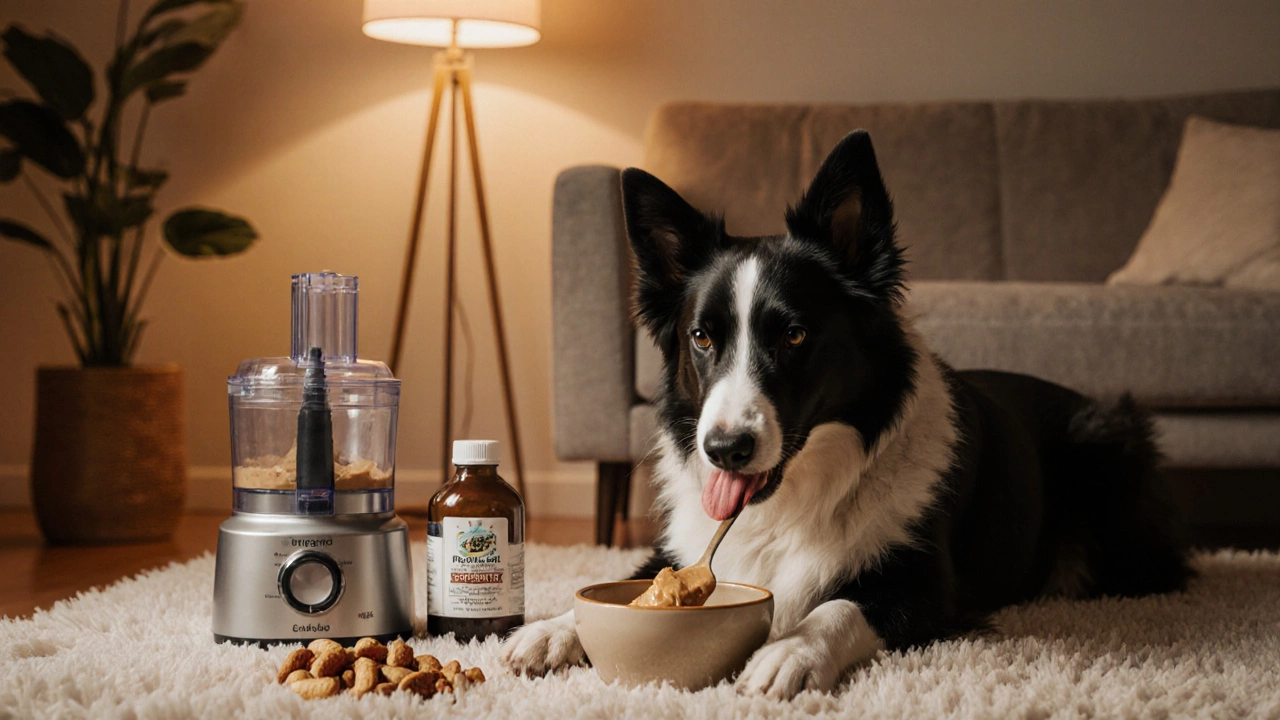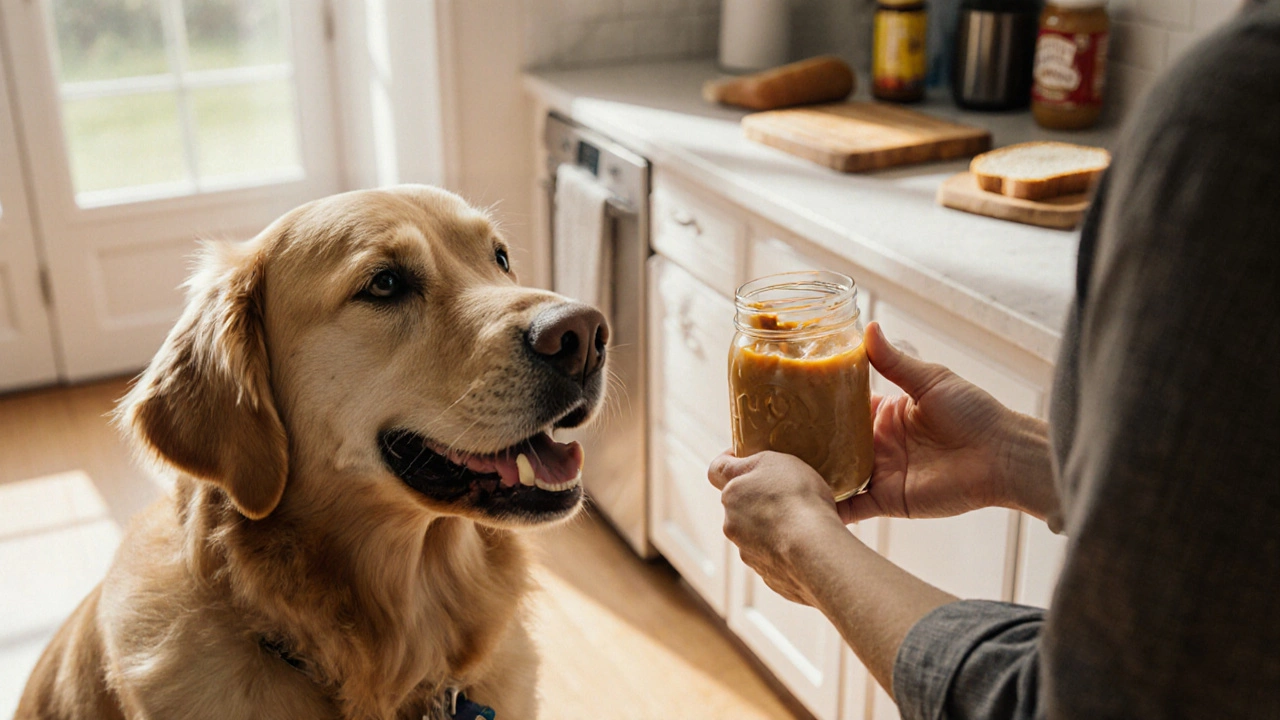Dog Peanut Butter Serving Calculator
Calculate safe peanut butter portions based on your dog's weight. Remember: Always check for Xylitol before feeding.
Enter your dog's weight to see recommended serving size.
Xylitol Warning
Even tiny amounts of Xylitol are deadly to dogs. Never give peanut butter containing Xylitol.
Ever wondered if the creamy spread you love on toast could double as a tasty treat for your furry friend? The answer isn’t as simple as “yes” or “no.” Not every jar is created equal, and a few hidden ingredients can turn a harmless snack into a health hazard for dogs. Below you’ll find the lowdown on what makes a jar of peanut butter for dogs truly safe, plus a side‑by‑side look at the most reliable brands on the market today.
Quick Takeaways
- Look for 100% peanuts, no added sugar, salt, or artificial sweeteners.
- Avoid any product that lists Xylitol - even a tiny amount is deadly.
- Portion control matters: a teaspoon per 20‑30 lb dog is a safe rule of thumb.
- Four top‑rated, dog‑safe brands are Smucker’s Natural, Teddie, Pip & Nut, Blue Buffalo, and Honest Kitchen.
- Making your own peanut butter at home guarantees nothing unwanted sneaks in.
Why Some Peanut Butters Are a Risk
Many commercial spreads contain sweeteners, salts, and preservatives that your dog’s digestive system isn’t built to handle. The most notorious culprit is Xylitol, a sugar substitute that can cause a rapid insulin surge, leading to hypoglycemia and liver failure in dogs. Other red flags include:
- Added sugars - excess calories and dental problems.
- High sodium - can aggravate heart disease.
- Artificial flavors or colors - potential allergens.
Even “low‑fat” or “reduced‑calorie” varieties often rely on these additives to keep the taste appealing. For a dog, less is more.
What Makes a Peanut Butter Dog‑Safe?
When scanning the label, aim for the following criteria:
- Ingredient list reads “Peanuts” (or “Roasted Peanuts”) and nothing else.
- No mention of Xylitol, sucralose, or other sugar alcohols.
- Salt content under 0.5 % (roughly 200 mg per tablespoon).
- Zero added sugars or honey.
- Certified by the FDA or meeting AAFCO standards for pet food additives.
If a jar checks all the boxes, you’ve got a safe treat that also supplies protein, healthy fats, and vitamin E - all benefits for shiny coats and brain health.
Top Dog‑Safe Peanut Butter Brands (2025)
| Brand | Ingredient Simplicity | Added Sugar | Sodium (mg/ tbsp) | Xylitol Free | Best For |
|---|---|---|---|---|---|
| Smucker's Natural | 100% peanuts, no oils | No | 150 | Yes | Everyday spoon‑feed |
| Teddie | Peanuts only, no salt | No | 0 | Yes | Low‑sodium diets |
| Pip & Nut | Organic peanuts, minimal salt | No | 80 | Yes | Organic‑focused owners |
| Blue Buffalo | Peanuts + coconut oil, no sweeteners | No | 120 | Yes | Active, high‑energy dogs |
| Honest Kitchen | Organic peanuts, pumpkin, no salt | No | 30 | Yes | Sensitive stomachs |
All five brands are free of Xylitol, have minimal sodium, and contain no added sugars. Pick the one that matches your dog’s dietary needs and your budget.
Serving Peanut Butter Safely
Even a perfectly safe brand becomes a problem if you overfeed. Here’s a quick cheat sheet:
- Small breeds (under 20 lb): ½ teaspoon per day.
- Medium breeds (20‑50 lb): 1 teaspoon per day.
- Large breeds (over 50 lb): 1-2 teaspoons per day.
Spread the spoonful over a kibble ball, hide it inside a Kong, or use it as a high‑value training reward. Watch for signs of stomach upset - loose stools, vomiting, or excessive gas - and cut back if anything looks off.

DIY Dog‑Friendly Peanut Butter
Making your own spread eliminates any doubt about hidden additives. You only need two ingredients:
- 2 cups of unsalted, dry‑roasted peanuts.
- 1 - 2 teaspoons of coconut oil (optional for smoother texture).
Pulse the peanuts in a food processor until they reach a creamy consistency. Add a splash of oil if you prefer a looser spread. Store in an airtight jar for up to two weeks in the fridge. No Xylitol, no sugar, and you control the salt level.
Red Flags on Labels
Even seasoned pet parents can miss sneaky wording. Keep an eye out for:
- "Reduced‑fat" - often compensated with sugar alcohols.
- "Contains Xylitol" - immediate discard.
- "Naturally flavored" - could still hide artificial sweeteners.
- "Contains sea salt" - may push sodium levels too high for dogs.
When in doubt, choose a brand that lists only "Peanuts" as the sole ingredient.
Frequently Asked Questions
Can a dog eat regular grocery‑store peanut butter?
Only if the label confirms it’s 100% peanuts with no added sugar, salt, or Xylitol. Most mainstream brands add at least one of those, so read the ingredient list carefully.
How much peanut butter is safe for a senior dog?
Senior dogs often have slower metabolism and joint concerns. Stick to the lower end of the serving guide - ½ teaspoon for small breeds, 1 teaspoon for medium, and no more than 1 teaspoon for large seniors, especially if they’re prone to weight gain.
Is organic peanut butter automatically safe?
Organic status only guarantees pesticide‑free peanuts. It doesn’t speak to added sugars, salt, or artificial sweeteners. Always verify the full ingredient list.
Can peanut butter cause allergies in dogs?
Allergies to peanuts are rare but possible. If your dog shows itching, ear infections, or gastrointestinal upset after a new treat, stop feeding it and consult your vet.
Is peanut butter good for a dog’s coat?
The healthy fats and vitamin E in peanuts can support a glossy coat, but the benefit only shows up when the treat is part of a balanced diet. Over‑feeding outweighs any skin benefits.
Bottom line: Not every jar is a dog‑friendly delight, but a handful of reputable brands and a quick label check can turn peanut butter into a safe, occasional treat. Follow the serving guidelines, keep an eye on ingredients, and enjoy the fun of watching your pup lick the spoon.

